
Between Planets is a juvenile science fiction novel by American writer Robert A. Heinlein, originally serialized in Blue Book magazine in 1951 as "Planets in Combat". It was published in hardcover that year by Scribner's as part of the Heinlein juveniles.
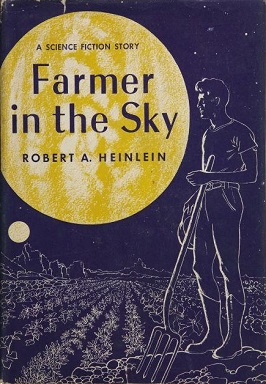
Farmer In The Sky is a 1950 science fiction novel by American writer Robert A. Heinlein about a teenaged boy who emigrates with his family to Jupiter's moon Ganymede, which is in the process of being terraformed. Among Heinlein's juveniles, a condensed version of the novel was published in serial form in Boys' Life magazine, under the title "Satellite Scout". The novel was awarded a Retro Hugo in 2001.
Edward Groff Conklin was an American science fiction anthologist. He edited 40 anthologies of science fiction, one of mystery stories, wrote books on home improvement and was a freelance writer on scientific subjects as well as a published poet. From 1950 to 1955, he was the book critic for Galaxy Science Fiction.
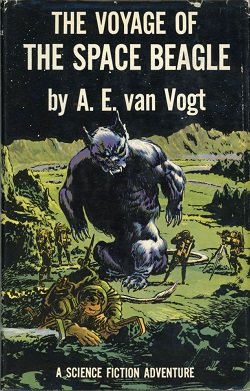
The Voyage of the Space Beagle (1950) is a science fiction novel by American writer A. E. van Vogt. An example of space opera subgenre, the novel is a "fix-up" compilation of four previously published stories:

Slan is a science fiction novel by American-Canadian writer A. E. van Vogt, as well as the name of the fictional race of superbeings featured in the novel. The novel was originally serialized in the magazine Astounding Science Fiction. It was subsequently published in hardcover in 1946 by Arkham House, in an edition of 4,051 copies. In 2016, Slan was awarded the Retro-Hugo Award for Best Novel for 1941.

Miles John Breuer was an American physician and science fiction writer of Czech origin. Although he had published elsewhere since the early 20th century, he is considered the part of the first generation of writers to appear regularly in the pulp science fiction magazines, publishing his first story, "The Man with the Strange Head", in the January 1927 issue of Amazing Stories. His best known works are "The Gostak and the Doshes" (1930) and two stories written jointly with Jack Williamson, "The Girl from Mars" (1929) and The Birth of a New Republic (1931).
Galaxy novels, sometimes titled Galaxy Science Fiction Novels, were a series of mostly reprint American science fiction novels published between 1950 and 1961.

Samuel Kimball Merwin Jr. was an American mystery fiction writer, editor and science fiction author. His pseudonyms included Elizabeth Deare Bennett, Matt Lee, Jacques Jean Ferrat and Carter Sprague.
"Loophole" is a science fiction short story by British writer Arthur C. Clarke, first published in 1946 in the magazine Astounding Science Fiction. It was subsequently published as part of a short story collection in A Treasury of Science Fiction (Groff Conklin, 1948 and Expedition to Earth in 1953.
The Heinlein juveniles are the science-fiction novels written by Robert A. Heinlein for Scribner's young-adult line. Each features "a young male protagonist entering the adult world of conflict, decisions, and responsibilities." Together, they tell a loosely connected story of space exploration. Scribner's published the first 12 between 1947 and 1958, but rejected the 13th, Starship Troopers. That one was instead published by Putnam. A 14th novel, Podkayne of Mars, is sometimes listed as a "Heinlein juvenile", although Heinlein himself did not consider it to be one.

Stowaway to Mars is a science fiction novel by British writer John Wyndham. It was first published in 1936 as Planet Plane, then serialised in The Passing Show as Stowaway to Mars and again in 1937 in Modern Wonder magazine as The Space Machine. The novel was written under one of Wyndham's early pen names, John Beynon. It was published by Coronet Books in 1972 as "Stowaway to Mars by John Wyndham".
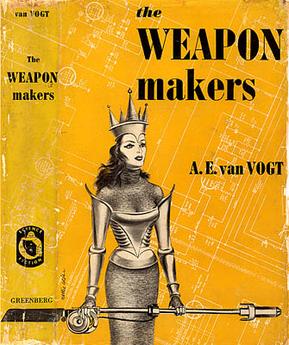
The Weapon Makers is a science fiction novel by American writer A. E. van Vogt.

The Moon Is Hell! is a collection of two stories, one science fiction, the other sword and sorcery, by American writer John W. Campbell Jr. It was published in 1951 by Fantasy Press in an edition of 4,206 copies. The title story, published for the first time in this collection, deals with a team of scientists stranded on the Moon when their spacecraft crashes, and how they use their combined skills and knowledge to survive until rescue, including building shelter from meteor showers, and creating their own oxygen from Lunar rock. The second story, "The Elder Gods", Campbell rewrote, on a short deadline, from a story by Arthur J. Burks purchased for Unknown but later deemed unsatisfactory. It originally appeared in the October 1939 issue of Unknown under the pseudonym Don A. Stuart. The title of the eponymous story is occasionally found without the exclamation point, but the punctuation is used for the title of most editions of the collection itself.
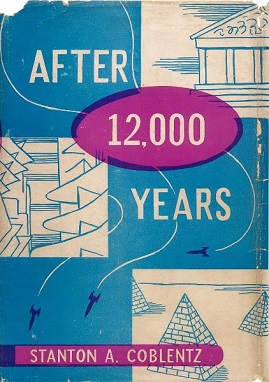
After 12,000 Years is a science fiction magazine serial and novel by American writer Stanton A. Coblentz. Considered one of the author's most bizarre and most interesting futuristic fantasies, the story originally appeared as a novella in the Spring 1929 issue of the magazine Amazing Stories Quarterly. It was later expanded and serialized for the pulp magazine Uncanny Tales in 1942, before being published in book form in 1950 by Fantasy Publishing Company, Inc. (FPCI). Lloyd Arthur Eshbach regarded this as one of the stronger titles published by FPCI. The story was abridged for the FPCI publication, in an edition of 1,000 copies, of which 750 were hardback. E. F. Bleiler considered the unabridged version to be superior.

One in Three Hundred is a science fiction novel by British writer J. T. McIntosh. It was originally published as three novellas in The Magazine of Fantasy and Science Fiction in 1953-54, and was then published by Doubleday & Company, Inc. During 1956 the novel was reissued by Ace as Ace Double D-113, in a dos-à-dos binding with Dwight V. Swain's The Transposed Man.

Science-Fiction Adventures in Dimension is an anthology of science fiction stories edited by Groff Conklin, first published by Vanguard Press in hardcover in 1953. An abridged edition was issued by Grayson & Grayson in the UK, and an abridged paperback edition, with a different selection of stories from the original, was issued by Berkley Books; both abridgments carried unhyphenated titles.

A Treasury of Science Fiction is an American anthology of science fiction short stories edited by Groff Conklin. It was first published in hardcover by Crown Publishers in 1948, and reprinted in March 1951. A later edition was issued by Bonanza Books/Crown Publishers in March 1980. An abridged paperback version including eight of its thirty stories was published by Berkley Books in July 1957 and reprinted in January 1958 and January 1965.

Possible Worlds of Science Fiction is an anthology of science fiction short stories edited by American anthologist Groff Conklin. It was first published in hardcover by Vanguard Press in 1951. An abridged hardback version including thirteen of its twenty-two stories was published by Grayson & Grayson in 1952; an abridged paperback version including ten of its twenty-two stories was published by Berkley Books in July 1955 and reprinted in April 1956, November 1960, January 1962 and November 1968.
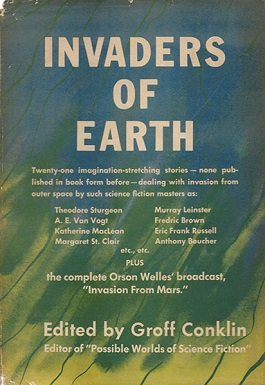
Invaders of Earth is an anthology of science fiction short stories edited by the American anthologist Groff Conklin. It was first published in hardcover by Vanguard Press in 1952. An abridged paperback edition including only 15 of the 22 stories was published by Pocket Books in July 1955. Another paperback edition, containing 17 of the original 22 stories was published by Tempo Books in September 1962 and reprinted in September 1964. The first British edition was published under the variant title Invaders of Earth - More Tales of Space and Time in hardcover by Weidenfeld & Nicolson in 1953 and reprinted in 1955. A two-volume British paperback edition, also abridged, was published by Digit in 1962, the first volume under the original title and the second under the title Enemies in Space; together, they included 14 of the original 22 stories.
The year 1950 was marked, in science fiction, by the following events.















